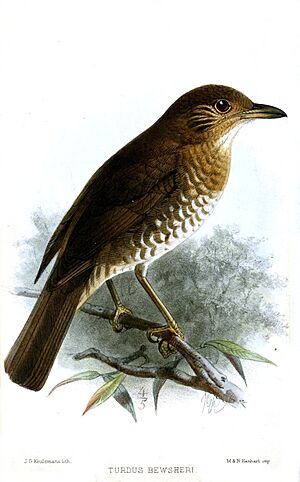Comoro thrush facts for kids
Quick facts for kids Comoro thrush |
|
|---|---|
 |
|
| Conservation status | |
| Scientific classification |
The Comoro thrush (Turdus bewsheri) is a special kind of bird that lives only on the Comoros Islands. These islands are located in the southwestern part of the Indian Ocean. It's a member of the Turdidae family, which includes many types of thrushes.
Contents
About the Comoro Thrush
What Does It Look Like?
The Comoro thrush is a brown bird. Its upper parts, like its back and head, have a slight olive green color. Its tail and wings are a bit more reddish-brown, which is called rufous.
The underside of the bird is mostly whitish. However, its sides are brown, and it has brown, scale-like patterns on its chest and belly. The very middle of its belly and the feathers under its tail are white.
Female Comoro thrushes are usually browner than the males, but they look quite similar otherwise. Young thrushes are even more reddish-brown. This bird is about 24 centimeters (about 9.5 inches) long.
What Does It Sound Like?
The song of the Comoro thrush is very musical and rich, like many other thrushes. The exact sound of their song can be a little different depending on which island they live on. When they are alarmed, they make a sharp "twit" sound. They also have a soft call they use to keep in touch with each other.
Where Does It Live?
Island Homes and Subspecies
The Comoro thrush lives only on the Comoros Islands. A species that lives only in one place is called endemic. There are three different types, or subspecies, of the Comoro thrush. Each one lives on a different island:
- Turdis bewsheri comorensis: This subspecies lives on Grand Comoro island.
- Turdis bewsheri moheliensis: This one lives on Mohéli island.
- Turdis bewsheri bewsheri: This subspecies is found on Anjouan island.
Their Natural Home
Comoro thrushes like to live in evergreen forests. These are forests where trees stay green all year round. They can be found both deep inside the forest and at the edges. They live from sea level (the height of the ocean) up to about 700 meters (about 2,300 feet) high.
However, the T.B. comorensis subspecies on Grand Comoro island lives higher up on Mount Karthala. This is because there are no forests lower down on that specific mountain.
How They Live
What Do They Eat?
The Comoro thrush usually looks for food low down, either in the plants close to the ground or directly on the ground. They search for spiders, grasshoppers, bugs, snails, and some fruits and seeds. Sometimes, they will fly higher into the trees to eat fruit from the canopy. They might also join groups of different bird species to forage together.
Nesting and Babies
Comoro thrushes usually breed from mid-August to October. They build a nest that looks like a cup. This nest is made from plant fibers and roots, covered with moss, and lined with soft grasses. They place their nests up to 3 meters (about 10 feet) off the ground. You might find a nest on a tree stump, among plants that grow on other plants (called epiphytes), or along a horizontal tree branch. A normal clutch (group of eggs) for them is two eggs.
Protecting the Comoro Thrush
The Comoro thrush is currently classified as "Near threatened" by the IUCN (International Union for Conservation of Nature). This means they are not in immediate danger, but their numbers could become threatened if things don't change.
The biggest problem for these birds is losing their homes. Forests are being cut down by local farmers to grow food, and trees are also cut for firewood. This loss of forest means the Comoro thrush has fewer places to live and find food. Protecting their forest homes is very important for their future.


